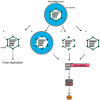Recognition of Reovirus RNAs by the Innate Immune System
- PMID: 32575691
- PMCID: PMC7354570
- DOI: 10.3390/v12060667
Recognition of Reovirus RNAs by the Innate Immune System
Abstract
Mammalian orthoreovirus (reovirus) is a dsRNA virus, which has long been used as a model system to study host-virus interactions. One of the earliest interactions during virus infection is the detection of the viral genomic material, and the consequent induction of an interferon (IFN) based antiviral response. Similar to the replication of related dsRNA viruses, the genomic material of reovirus is thought to remain protected by viral structural proteins throughout infection. Thus, how innate immune sensor proteins gain access to the viral genomic material, is incompletely understood. This review summarizes currently known information about the innate immune recognition of the reovirus genomic material. Using this information, we propose hypotheses about host detection of reovirus.
Keywords: dsRNA; innate immunity; interferon; reovirus; sensing.
Conflict of interest statement
The authors declare no conflict of interest.
Figures


Similar articles
-
Early Events in Reovirus Infection Influence Induction of Innate Immune Response.J Virol. 2022 Jul 27;96(14):e0091722. doi: 10.1128/jvi.00917-22. Epub 2022 Jul 6. J Virol. 2022. PMID: 35867576 Free PMC article.
-
Inhibition of antiviral innate immunity by birnavirus VP3 protein via blockage of viral double-stranded RNA binding to the host cytoplasmic RNA detector MDA5.J Virol. 2014 Oct;88(19):11154-65. doi: 10.1128/JVI.01115-14. Epub 2014 Jul 16. J Virol. 2014. PMID: 25031338 Free PMC article.
-
Grass Carp Reovirus VP56 Allies VP4, Recruits, Blocks, and Degrades RIG-I to More Effectively Attenuate IFN Responses and Facilitate Viral Evasion.Microbiol Spectr. 2021 Oct 31;9(2):e0100021. doi: 10.1128/Spectrum.01000-21. Epub 2021 Sep 15. Microbiol Spectr. 2021. PMID: 34523975 Free PMC article.
-
In vitro production of synthetic viral RNAs and their delivery into mammalian cells and the application of viral RNAs in the study of innate interferon responses.Methods. 2020 Nov 1;183:21-29. doi: 10.1016/j.ymeth.2019.10.013. Epub 2019 Nov 1. Methods. 2020. PMID: 31682923 Review.
-
Paramyxovirus activation and inhibition of innate immune responses.J Mol Biol. 2013 Dec 13;425(24):4872-92. doi: 10.1016/j.jmb.2013.09.015. Epub 2013 Sep 20. J Mol Biol. 2013. PMID: 24056173 Free PMC article. Review.
Cited by
-
The μ2 and λ1 Proteins of Mammalian Reovirus Modulate Early Events Leading to Induction of the Interferon Signaling Network.Viruses. 2022 Nov 26;14(12):2638. doi: 10.3390/v14122638. Viruses. 2022. PMID: 36560642 Free PMC article.
-
Oral reovirus reshapes the gut microbiome and enhances antitumor immunity in colon cancer.Nat Commun. 2024 Oct 22;15(1):9092. doi: 10.1038/s41467-024-53347-6. Nat Commun. 2024. PMID: 39438458 Free PMC article.
-
A Single Point Mutation, Asn16→Lys, Dictates the Temperature-Sensitivity of the Reovirus tsG453 Mutant.Viruses. 2021 Feb 12;13(2):289. doi: 10.3390/v13020289. Viruses. 2021. PMID: 33673179 Free PMC article.
-
Cellular origins of dsRNA, their recognition and consequences.Nat Rev Mol Cell Biol. 2022 Apr;23(4):286-301. doi: 10.1038/s41580-021-00430-1. Epub 2021 Nov 23. Nat Rev Mol Cell Biol. 2022. PMID: 34815573 Free PMC article. Review.
-
Reovirus Activated Cell Death Pathways.Cells. 2022 May 27;11(11):1757. doi: 10.3390/cells11111757. Cells. 2022. PMID: 35681452 Free PMC article. Review.
References
-
- Knipe D.M., Howley P. Fields Virology. Wolters Kluwer Health; Philadelphia, PA, USA: 2013.
Publication types
MeSH terms
Substances
Grants and funding
LinkOut - more resources
Full Text Sources

